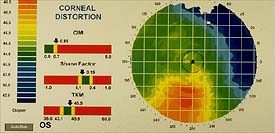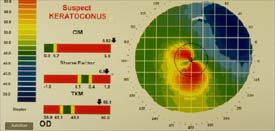Corneal warpage: make a careful diagnosis, stabilize condition before proceeding
Never before have we had so many options available for our patients who desire freedom from spectacles. This is true for all refractive error conditions including astigmatism and presbyopia. However, providing new alternatives to our habitual long-term contact lens wearers poses new challenges. Long-term contact lens wear can alter corneal physiology and corneal topography and can cause transient but substantial refractive error changes.
A combination of the latter two are often referred to as “corneal warpage syndrome.” It is important to recognize these changes and initiate corneal rehabilitation prior to changing to alternative refractive error correction modes such as soft torics, multifocal contact lenses, orthokeratology or refractive surgery. The ultimate goal of rehabilitation is to prevent unnecessary lens re-orders, time and, more importantly, over- or under-corrections after refractive surgery. Operating on or fitting a changing cornea is essentially like chasing a moving target.
Warpage symptoms
Frequently, with corneal warpage, the only subjective complaint is that of spectacle blur. Blur with the habitual contact lenses is not typical unless accompanied by a physiologic response, such as microcysts or corneal edema. The exception to this can occur in rigid multifocal lens wear. Aspheric gas-permeable (GP) lens designs are highly eccentric — with posterior lens curvature that flattens quickly from center to periphery.
As such, the lenses are often fitted 2 D to 4 D steeper than flat K to achieve centration. This results in both positive and negative pressure gradients that can redistribute corneal tissue and cause dramatic topographical changes. With long-term wear and the presence of subsequent corneal topographical changes, the multifocal effect can be compromised and can cause a reduction in visual acuity with the contact lenses.
|
|
Corneal topography appearance
Corneal warpage can be identified based on the appearance of the corneal topographical maps, which typically show bilateral and fairly symmetrical superior flattening and dramatic inferior steepening. Also, a characteristic “scissors-reflex” is often apparent with retinoscopy.
The appearance of the topography and retinoscopic reflex is very similar to peripheral inferior ectasia seen in keratoconus; therefore, it is important to differentiate the two conditions. Although keratoconus is most often a bilateral disease, the progression is typically asymmetrical between the two eyes; whereas, in corneal warpage syndrome, the corneal maps often are relatively symmetrical in appearance.
Discontinuation of rigid contact lens wear and evaluating serial corneal topography and refraction are critical in the differential diagnosis. Generally, the topography of a corneal warpage syndrome case will show dramatic changes over the initial few weeks of rehabilitation, and, ultimately, the vertical meridian will display a more symmetrical “bow-tie” astigmatic appearance.
Keratoconus findings
In keratoconus, the superior flattening and marked inferior steepening remains unchanged or may even become more prominent. The retinoscopic reflex will change as the corneal topography becomes more symmetrical after rehabilitation in cases of warpage; however, in keratoconus, the scissors reflex remains.
In the classic, progressive type of keratoconus, distinct slit-lamp findings are generally observed and are used to confirm the diagnosis. These include Vogt’s striae, Fleisher ring, prominent corneal nerves and apical scarring. In corneal warpage syndrome, these slit-lamp findings are not present. Initially, differentiating between form fruste keratoconus and corneal warpage can be more difficult. Long-term rigid contact lens wear, similar corneal topography and the absence of the key slit-lamp findings are common denominators in both conditions; therefore, serial topography and serial refractions are the key to differentiation. The topography, refraction or retinoscopic reflex of patients with either form of keratoconus typically would not improve nor stabilize after discontinuing contact lens wear.
Sophisticated software packages in some of the commercially available topographers also aid in differentiating warpage from ectactic conditions. One example is the Pathfinder Corneal Analysis, an optional program designed specifically for the Humphrey corneal topography systems. It identifies abnormal (corneal distortion), pathologic and normal corneas by comparing three statistical indices that gauge the shape (Shape Factor), regularity (Corneal Irregularity Measurement) and toricity (Mean Toric Keratometry) of the cornea. The software package quickly provides an initial diagnosis for patients displaying topographical asymmetry; however, serial topography and refractions provide the definitive answer.
Finally, fluorescein patterns can provide clues for the differential diagnosis. Corneal warpage is often seen with a rigid lens fit that is decentered superiorly along the vertical meridian and often displays an apical bearing or flat fitting relationship.
Another common scenario occurs when a spherical rigid contact lens is worn on a moderately toric cornea. This can result in a flattening of the steep corneal meridian and the subsequent “sphericalization” of the refractive error. In this scenario, the fluorescein pattern may display excessive mid-peripheral bearing in the characteristic “figure 8” pattern along the flattest corneal meridian with excessive clearance in the steeper meridian. This effect can be minimized or avoided by designing toric contact lenses that more closely resemble the shape of the patient’s cornea and do not cause the molding phenomenon and refractive error changes seen with the spherical lens design.
Corneal rehabilitation
 Corneal rehabilitation involves the discontinuation of wearing the habitual contact lenses until the topographical and refractive error changes stabilize. Some other form of refractive error correction that does not induce further unwanted tissue compression or redistribution is required. This can pose a significant challenge due to the fact that both the spherical and astigmatic refractive error may change substantially over a short period of time.
Corneal rehabilitation involves the discontinuation of wearing the habitual contact lenses until the topographical and refractive error changes stabilize. Some other form of refractive error correction that does not induce further unwanted tissue compression or redistribution is required. This can pose a significant challenge due to the fact that both the spherical and astigmatic refractive error may change substantially over a short period of time.
These patients are often best managed by fitting them with either spherical or toric disposable soft contact lenses until the refractive error stabilizes to the point that an adequate spectacle prescription can be dispensed. Frequent lens power changes are necessary; therefore, the patients should be followed regularly during the course of rehabilitation.
Deciding when a previous contact lens wearer is ready for refractive surgery or a specialty contact lens design must include assessing the stability of both the refractive error and corneal topography. The amount of time required for rehabilitation depends on the type, mode and length of previous contact lens wear.
Current research findings
A recent study published by Wang and colleagues outlined the time to resolution of contact lens-induced corneal warpage prior to refractive surgery. In 165 consecutive long-term (10 to 30 years) contact lens-wearing patients evaluated for refractive surgery, a 12% incidence of corneal warpage was observed. This was accompanied by up to 3.0 D refractive and 2.5 D keratometric shifts and significant topographical changes.
After discontinuation of lens wear, recovery time depended upon the type of lens worn. It has been fairly accepted that habitual GP lens wearers need a longer period of rehabilitation prior to refractive surgery than daily soft contact lens wearers. However, these data indicate that patients habitually wearing low-Dk soft lenses in an extended-wear modality may need the longest recovery period.
The other significant finding was that the soft toric lens-wearing group required an average of 5.5 weeks for resolution of corneal warpage. The bottom line is this: the often-recommended protocol of discontinuing soft contact lens wear 48 to 72 hours prior to refractive surgery is not enough for many patients, especially those with identified corneal warpage syndrome.
Previously, spectacle blur and topographical changes have often been viewed as a normal consequence of contact lens wear. With the recent availability of highly gas-permeable materials, improved lens designs and sophisticated corneal mapping systems, corneal integrity and shape can be maintained and monitored to reduce the incidence and severity of this common sequelae.



